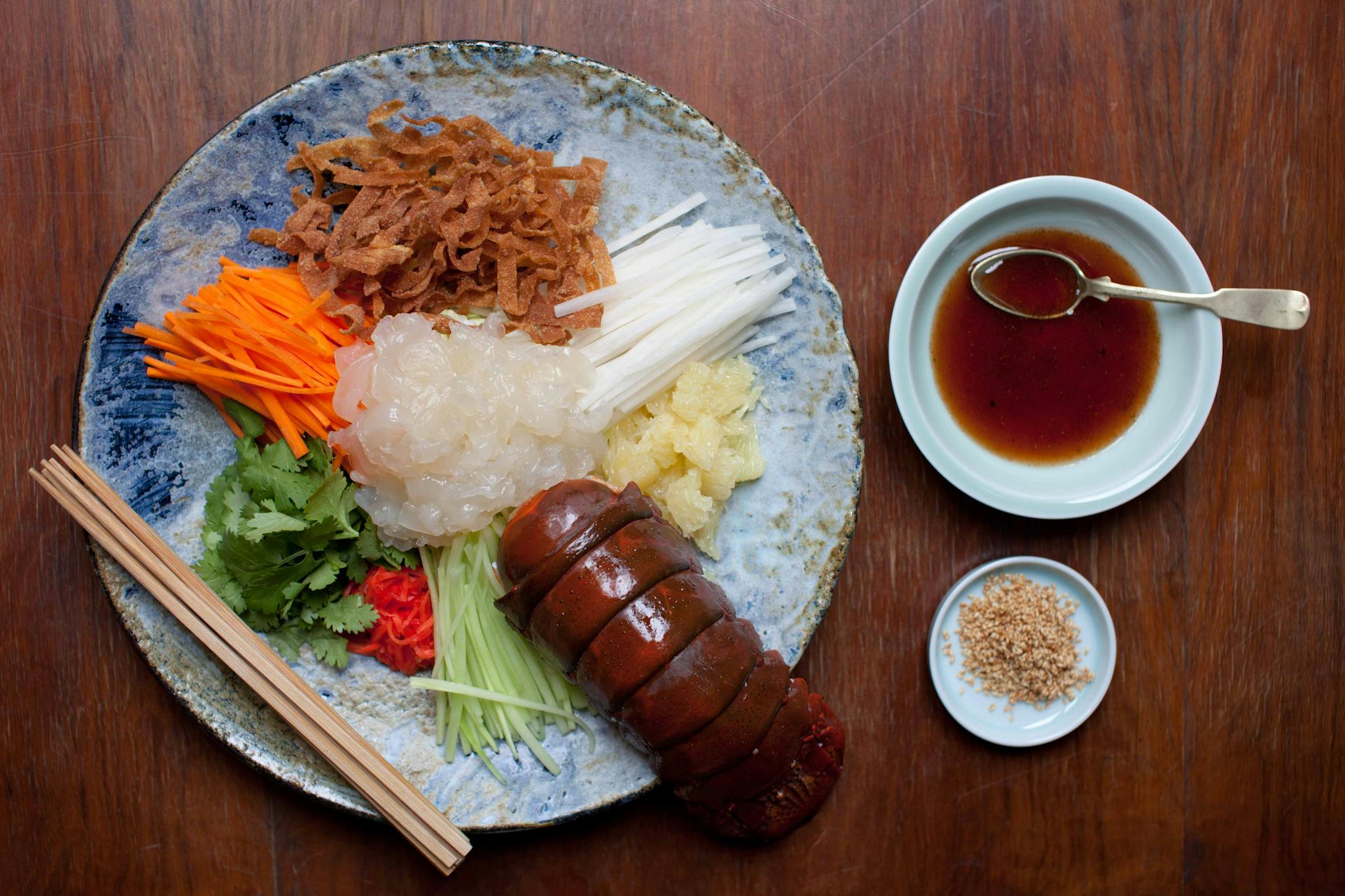Dragon Yee Sang

Chinese New Year is coming up in a few days and I so I thought I'd share with you one of my favourite CNY dishes.
Yee Sang is a very popular Chinese New Year dish around Malaysia and Singapore (Do people eat this in China or Hong Kong? I really don't know), and my family usually eat this on the eve of Chap Goh Meh, which is the 15th and final day of the new year festival.
Yee Sang is a colourful salad of prosperous ingredients, which are tossed together with a sweet dressing. Everyone around the table puts their chopsticks into the salad and tosses it high in the air. The superstition goes that the higher the salad is tossed, the more luck that will come in the new year. It's can get a bit messy, but tossing the yee sang are some of my favourite memories of my childhood.
There are lots of recipes for Yee Sang around, and most of them use raw salmon or smoked salmon but I thought that this year, because it is the year of the Water Dragon, I would use lobster sashimi instead. Of course, if you want a more traditional yee sang, just substitute the lobster sashimi with another raw fish.
Chinese new year foods are full of symbolism - Fish symbolise wealth because 'yu', the Chinese word for fish, is synonymous with the words for wealth and abundance. Long noodles signify a long life. Oranges signify good luck, and pomelos or grapefruits also signify wealth and prosperity. One of the most popular areas of symbolism is the balance between yin and yang, or the dragon and phoenix. In food the dragon is often symbolised by lobster or prawns, and the phoenix is often symbolised by pheasant or chicken. In this year of the Water Dragon, what could be more fitting than a celebratory dish paying homage to the symbolic Water Dragon, the lobster.
Ingredients
- 1 live lobster
- 6 wonton wrappers
- Oil for deep frying
- 1 tbsp white sesame seeds
- 1 carrot, peeled and julienned
- ½ Continental cucumber, peeled, deseeded and julienned
- ½ daikon white radish, julienned
- 6 leaves Chinese cabbage (hakusai, lombok), shredded
- 1 cup pomelo or grapefruit, torn into small pieces (peel, pith, seeds and any membrane removed)
- 1 bunch fresh coriander, leaves picked
- 2 tbsp Japanese red pickled ginger (benishouga)
- Dressing
- 150ml plum sauce
- 2 tbsp honey
- juice of 2-3 limes
- 1 tbsp soy sauce
- 1 tsp sesame oil
- 1 tbsp peanut oil
- ¼ tsp five spice powder
Method
- Slice the wonton wrappers into thin strips and deep fry in batches in hot oil until crispy, then set aside to drain. Don't fry too many at one time or they will stick together. Also, it's best not to slice the wrappers all stacked together, or they may clump on the board. Toast the sesame seeds in a dry frypan until golden brown and then set aside to cool.
- Julienne the cabbage, daikon, carrot and cucumber. Arrange these on a large platter and separately place on the pickled ginger, coriander and wonton crisps around in separate piles.
- To prepare the lobster, chill the lobster in the freezer for about 2 hours until it is asleep. Kill it quickly with a spike through the head and separate the meaty tail from the head. Cut down either side of the soft underside of the lobster and remove the flesh from the shell using your hands, and using a paring knife if necessary. Remove the vein from the lobster as neatly as possible and wipe away any residue. Although I don't recommend this, if the lobster meat is very dirty and you feel that you have to, you can rinse the meat very quickly in a mixture of iced water and salt (using enough salt to give the mixture the saltiness of seawater).
- Heat a large pot of water until boiling and add the lobster head and tail shell to the pot and boil until the shell changes colour. Clean the shells and remove any meat that was clinging to the shell, reserving it for another purpose (an egg white omelette with cream and spring onion is perfect, or you can just dip it in a little yuzu kosho tabasco - but that's a recipe for another time...)
- With a very sharp knife, slice the lobster into very thin slices and arrange over the centre of the salad.
- If you would like to use the tail for presentation, clean it well with a paper towel and, if it's looking a little dull, polish the outside with a small amount of oil.
- For the dressing, mix together all the ingredients.

